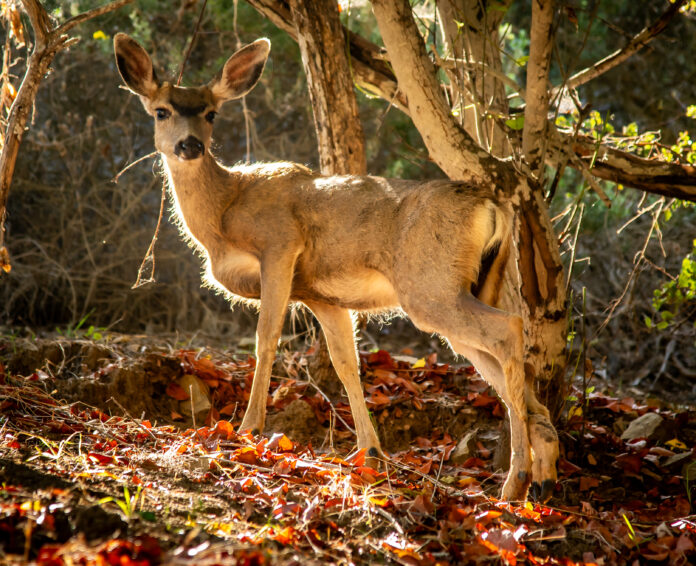
A male mule deer recently visited third-graders in Avalon. Their teacher sent the Islander a photog of the buck’s visit.
The Catalina Island Conservancy argues that mule deer pose a threat to the Island and its endangered plant species. The Conservancy website, in the FAQs page for the Conservancy’s Restoration Project, says the deer population is too large for the Island and that is causing them to starve.
Many Island residents, however, oppose the Conservancy’s proposal to remove the Island’s deer population by having White Buffalo, Inc., shoot them from helicopters. The proposal was confirmed by Conservancy Senior Conservation Director Lauren Dennhardt.
Dennhardt said the Conservancy was looking to start the deer removal in late 2024.
It will be up to the California Department of Fish and Wildlife to approve the proposal.
As of 9:39 a.m., Thursday, Oct. 5, an online petition to “Stop the Slaughter of Mule Deer on Catalina Island” had gathered 5,379 signatures. The future of the Island’s deer was discussed briefly during this week’s City Council meeting.
Council
The Avalon City Council received one letter from a resident who opposed the Conservancy’s Restoration Plan for the Island, which includes the killing of the deer. On Oct. 3, City Manager David Maistros told the council that he had invited the Conservancy to give a presentation on their restoration plan. Maistros also told the council that the Conservancy was planning to have open forums.
“I know that a lot of people have reached out to us concerning the Conservancy’s plan,” Councilmember Mary Schickling said.
“To those people, it is a Conservancy thing. So I don’t really see that we have any power to do anything with that,” Schickling said.
Councilmember Yesenia De La Rosa wanted residents to know that even though the council did not have jurisdiction, they are still Avalon residents and the council was still advocating for them to be heard.
Population
The Conservancy’s Private Land Management “2021 Annual Report” put the Island’s deer population at 1,771. Senior Conservation Director Lauren Dennhardt recently said that because of recent rains, the population was now likely at 2,000. According to page 15 of the document, the estimated deer population in Avalon was more than 200 deer in 2021. The report, submitted to the state Fish and Wildlife Department, argued the case for removing the deer population.
The petition
The online petition at change.org was put up by Save Our Catalina Mule Deer. The petition disagrees with arguments made in the conservancy’s Private Land Management 118-page report to the Department of Fish and Wildlife. The PLM document argues that eliminating the deer population is the most effective option for the Island. “The report submitted to the CDFW is clearly a predetermined conclusion supported by assumptions,” according to the petition.
The petition argued that there was no information about the impact of other animals on the local plant life.
The petition also questioned the Conservancy’s transparency on the issue.
The Conservancy
The Conservancy’s Senior Conservation Director Lauren Dennhardt is an Island resident. She has a PhD in biology/biological sciences, general, from North Dakota State University.
Dennhardt said the Conservancy has been talking about overpopulation of deer for years. Dennhardt said the Conservancy has run a hunting program for 25 years. According to her, the Conservancy always has tags left over. Yet Catalina has the longest deer hunting season in the state.
According to Dennhardt, the hunting program doesn’t seem to be controlling the deer population.
Dennhardt said the Conservancy has made the difficult choice to use lethal removal. She said the National Humane Society agreed. (The Catalina Humane Society, in a recent Letter to the Editor, opposes the killing of the deer.)
According to Dennhardt, the rugged terrain on Catalina makes using helicopters to remove the deer the safest way to carry out the project.
Dennhardt argued that if the Conservancy wasn’t transparent about the project, how would everyone know about them. She also said she had met with 70 people in recent months.
“We don’t take this lightly,” Dennhardt said.
“Unfortunately, this is really the only path forward for the health of the Island,” Dennhardt said.
Dennhardt is aware of the backlash against the proposal. “This is one of the first animal eradications in the age of social media,” Dennhardt said.
“This isn’t a battle between plants and animals. It’s a battle between the deer and the Island and right now, both are losing,” Dennhardt said.
As for alternatives, Dennhardt said the alternative to removing the deer was the hunting program. She said there are not as many hunters as there used to be.
Dennhardt argued that physically removing the deer could harm them and cause them to die more slowly.
“We have nothing to hide here,” Dennhardt said.









